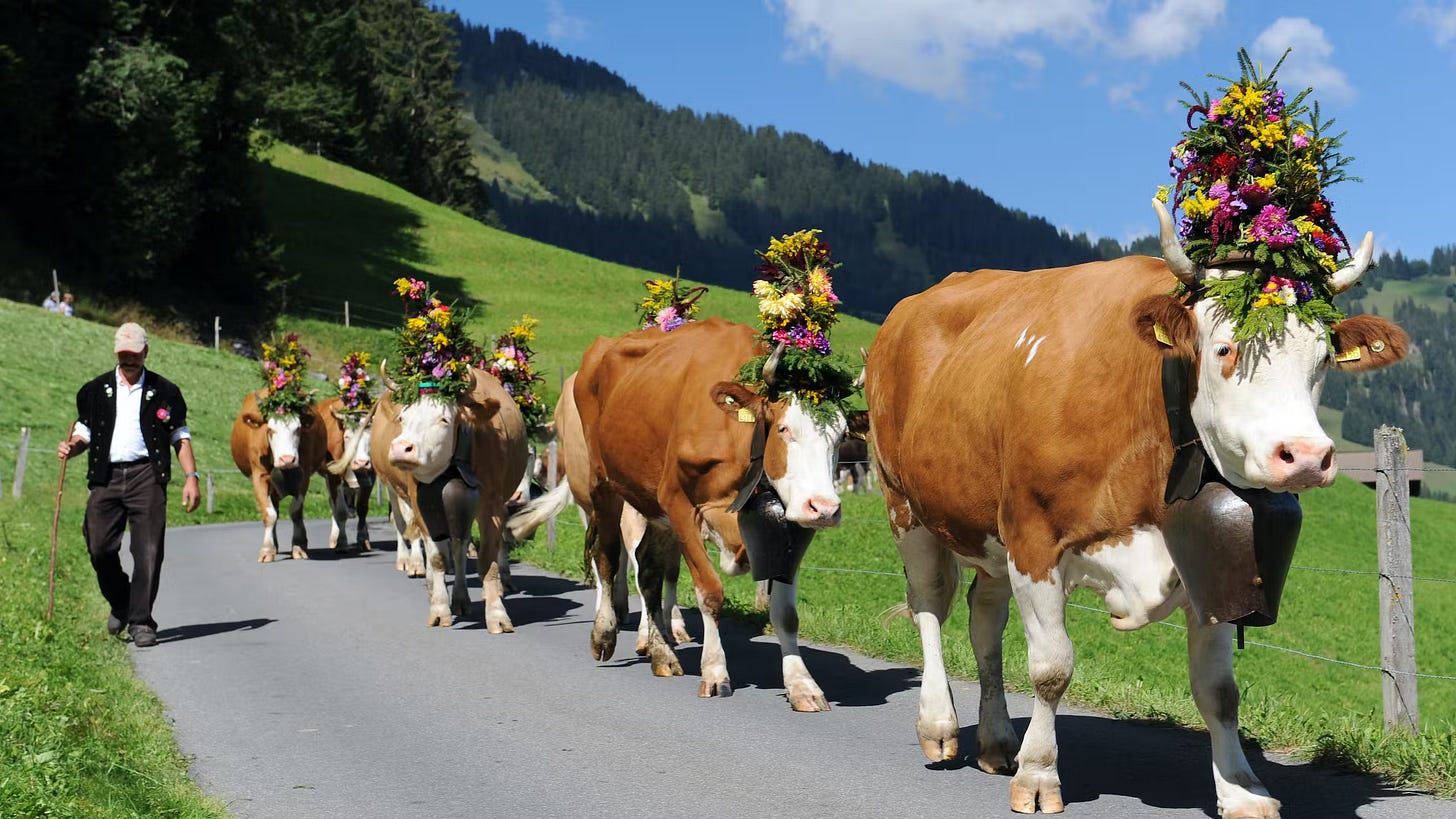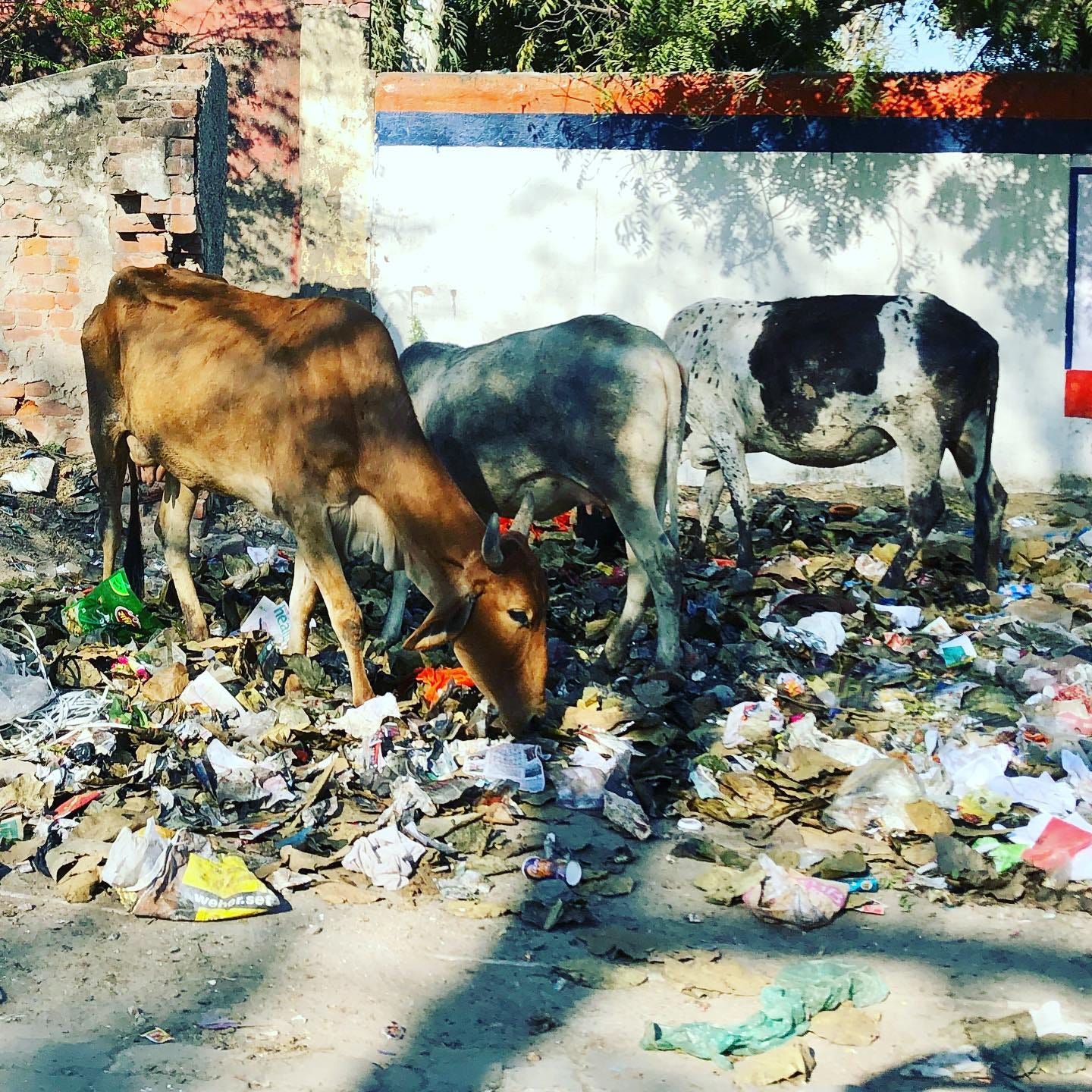Hola Folks,
Hope you’ve been well. I’ve been seeing a lot more of the inside of a hospital than I’d have liked to these last few weeks, and I must warn you that a short hiatus in publishing The Global Jigsaw is possibly round the corner. I will update you on that. In the while, do subscribe, if you haven’t yet.
And do share this newsletter with others who might enjoy it
Vamos. On to today’s post.
On a recent trip to Switzerland’s Bernese-Oberland area, I was captivated by the Alpine scenery. Sheets of flowers draped the valleys, punctuated by singing rivers and framed by snow-clad peaks.
Murren, Switzerland. Pic credit: Pallavi Aiyar
I was less captivated, more bemused, by the hordes of Indian tourists eating parathas (true story) on the summit of Schilthorn and pouting for selfies in every available meadow. The zeal of their selfie-taking was only matched by their enthusiasm for taking photos of cows.
I get it. Swiss cows are a thing of wonder. They radiate good health, from their lush, rounded bellies, to their glossy skin. The tinkling of the bells lovingly tied around their necks is the very definition of bucolic.
Pic credit: © Andreas Mueller
I found it ironic how Indian tourists seemed as transfixed by Swiss cows, as most Westerners are by the sight of Indian cows in city traffic. The cow is the thread that binds Switzerland and India, even as it underscores their irreducible differences
Switzerland is India’s most obvious, “other.” Orderly, clean, punctual and with stunning natural vistas unspoiled by overpopulation, effluents, or air pollution. For Indians, Switzerland is simply too good to be real. It is a dream.
I suppose that’s why it has long been the preferred setting for Bollywood “dream sequences.” For the uninitiated, the dream sequence in a Hindi movie refers to a romantic interlude, wholly separate from the plot, wherein the male and female protagonists suddenly find themselves transported to a “dream” land - often Switzerland – preforming their amorous fantasies through dance, song, and prancing around Alpine peaks in inadequate clothing.
The cow is as important to Switzerland’s sense of self as it is to India’s. Cow festivals in honor of the ascent (alpage) and descent (désalpe) of cattle into alpine meadows are a much-anticipated part of the nation’s annual calendar. Cattle are adorned with headdresses of flowers and other decorations and huge crowds gather to gaze upon the bovine processions. Cow bells take up a sizable portion of every souvenir shop in the country.
There are almost 20,000 dairy farmers in Switzerland and together they produce some 4 billion kilograms of milk annually. The Swiss milk industry generates billions of francs in revenue per year. In other words, cattle continue to be a mainstay of the Swiss economy. Swiss chocolate and cheese, need milk.
The difference between Switzerland and India is that while the Swiss treat their cows with an almost religious veneration, in India there is no “almost.” In Hinduism, cow-worship is - increasingly - a central part of religious practice.
The origin of cow-veneration in India dates as far back as the Vedic period (2nd millennium–7th century BCE). The Indo-European peoples who entered India in the 2nd millennium BCE were pastoralists. The economic significance of cattle to their society was reflected in their religion. Five cow products—milk, curd, butter, urine, and dung – known as the panchagavya are used in a range of religious rituals to do with healing, purification, and penance.
Over time, the slaughter of milk-producing cows became socially unacceptable in some parts of the country. But it was in the 19th century that a movement to protect cows first emerged as a political force. The cow became a rallying cry to unify Hindus and to distinguish them from beef-eating Muslims, by demanding that the government ban cow slaughter. This intertwining of political and religious purpose has reached a crescendo in recent years. (If interested, I did a piece on this for Nikkei Asia which you can access here).
But an interesting question to ask would be whether if you were a cow, you’d prefer to be a Swiss one or an Indian one. Personally, I’d plump for Swiss. Sure, I might be eaten one day, but in the time I do have, the care I’d likely receive would be top notch. In Switzerland, cattle cannot be transported for more than six hours and there are studies to ensure the perfect decibel level of cow bells to minimize aural irritation. As a Swiss cow, I’d even be provided with a support bra for my udders if they got painfully engorged.
On the hand, as a cow in India, I might have vigilante gangs ready to murder random people they suspect of eating beef in my name. But I would also face the likelihood of being abandoned by owners for whom I am financially nonviable to look after. Like the 5.2 million other stray cattle in the country, I would then be reduced to wandering urban streets, dodging traffic and foraging in garbage dumps.
Pic credit: Jane Craigie.
What would you choose?
*****
I’d love your feedback to this, and other posts published by the Global Jigsaw. Make sure to read any that you’ve missed out on. The full archive is available at
Thanks for reading. Hasta pronto,
Pallavi








Thanks Pallavi for this contribution. You might prefer to be a Swiss cow, but don't overlook the dramatic fall in milk consumption in Switzerland, where kids like me used to get a glass of milk every morning.. which is all part of a "dream sequence" now. And of course Swiss dairy farms are closing rapidly, and were it not for subsidies, most would already be gone. https://www.leadertelegram.com/country-today/farm-news/swiss-distress-small-scale-dairy-industry-in-decline-in-switzerland/article_3dded80a-5621-540e-8f34-c48c56a5a485.html
An interesting piece on cows. Having lived in India, (Calcutta), for many years and now living in Switzerland; I am constantly struck by both nation’s veneration of this animal. I do agree with you that being a Swiss cow is a, significantly, better prospect than an Indian one. The care and attention given to these food producing cornerstones of Swiss life go far beyond normal animal husbandry, (something for which the Swiss are very fierce about). The cattle are accompanied up to their summer alpine pastures with farmers living apart from their human families until the return in late September/October. The fertiliser they provide is used, extensively, to produce other crops as well as helping the alpine meadows replenish. In contrast, the Indian cow, though venerated, is often abandoned to wander the streets and fend for itself. Yes, it’s “free” but lives out its life fighting for food and shelter in an unsuitable environment.